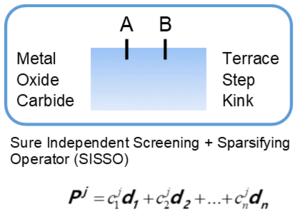
Predictive-quality theory and computer simulations may provide crucial input to understand heterogeneous catalysis, e.g. in the form of adsorption energies of key atoms or molecules at different types of active site motifs of the catalyst material. While it is possible to use quantum mechanical calculations (density functional theory, DFT) to study simple reactions and simple model catalysts such as high-index facets of metals or oxides, the computational demands of such an approach can quickly become prohibitively large for realistic materials.
The use of machine learning (ML) and related techniques to make accurate and low-cost predictions of quantum mechanical calculations has gained increasing attention lately. In recent works we have explored the possibilities for using a compressed sensing method (Sure Independence Screening and Sparsifying Operator, SISSO) to identify sparse (low-dimensional) descriptors for the prediction of adsorption energies at various active site motifs of metals and oxides. We start from a set of physically motivated primary features such as atomic acid/base properties, coordination numbers or band moments and let the data and the compressed sensing method find the best algebraic combination of these features. While this approach works well for simple adsorbates, it is of limited accuracy for larger molecules that may bind to the surface in different orientations and in configurations where two or more atoms in the molecule form chemical bonds to the atoms in the catalyst surface. To predict adsorption energies of such complex adsorbates at metal and alloy surfaces, we recently developed a ML approach based on graph theory, a customized Wasserstein Weisfeiler-Lehman (WWL) graph kernel and Gaussian process regression (GPR). Furthermore, we integrate the ML-based predictions with traditional catalysis modeling techniques from thermal and electro-catalysis such as the computational hydrogen electrode or microkinetic modeling.
Read more about our work: